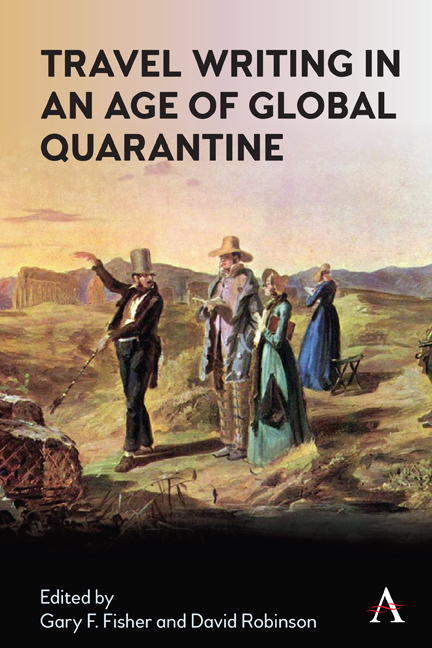Book contents
- Frontmatter
- Contents
- Foreword
- Acknowledgements
- Introduction
- Chapter One ‘Off-Stage, A War’: Wuhan, 1938
- Chapter Two Frederic Lees in Varese Ligure, 1911
- Chapter Three ‘A Rude People Subjected to No Restraint’: In Tanimbar with Anna Keith Forbes, Henry Forbes and So’u Melatunan
- Chapter Four Sent to Coventry: A Journey Home?
- Chapter Five Bedouin Is a Place: Freya Stark’s Travel with Nomads
- Chapter Six With Wilkie in the West: Reading Wilkie Collins’s Rambles beyond Railways from a Cornish Perspective
- Chapter Seven Picturing Rome: Walking the Eternal City with the Last Victorian
- Chapter Eight Su e zo per i ponti; or, How History Does Not Help
- Chapter Nine A Town Called Entropy: Boom and Bust in Arnold Bennett’s Potteries
- Chapter Ten Travelling towards Transculturalism? Statues, Remembrance and Mourning in Bloemfontein, South Africa
- Chapter Eleven Recollections of the King’s House
- Chapter Twelve Occupying Her Time: Ginette Eboué, France, 1940–42
- Epilogue
- List of Contributors
- Works Cited
Chapter Two - Frederic Lees in Varese Ligure, 1911
Published online by Cambridge University Press: 18 November 2021
- Frontmatter
- Contents
- Foreword
- Acknowledgements
- Introduction
- Chapter One ‘Off-Stage, A War’: Wuhan, 1938
- Chapter Two Frederic Lees in Varese Ligure, 1911
- Chapter Three ‘A Rude People Subjected to No Restraint’: In Tanimbar with Anna Keith Forbes, Henry Forbes and So’u Melatunan
- Chapter Four Sent to Coventry: A Journey Home?
- Chapter Five Bedouin Is a Place: Freya Stark’s Travel with Nomads
- Chapter Six With Wilkie in the West: Reading Wilkie Collins’s Rambles beyond Railways from a Cornish Perspective
- Chapter Seven Picturing Rome: Walking the Eternal City with the Last Victorian
- Chapter Eight Su e zo per i ponti; or, How History Does Not Help
- Chapter Nine A Town Called Entropy: Boom and Bust in Arnold Bennett’s Potteries
- Chapter Ten Travelling towards Transculturalism? Statues, Remembrance and Mourning in Bloemfontein, South Africa
- Chapter Eleven Recollections of the King’s House
- Chapter Twelve Occupying Her Time: Ginette Eboué, France, 1940–42
- Epilogue
- List of Contributors
- Works Cited
Summary
I first visited Varese Ligure in January 1995. It was very cold. There was thick ice along the roadsides. The hotel I stayed at, the ancient Albergo Amici founded in 1760 and run by the Marcone family ever since, was freezing, as the heating had broken down just before we arrived. We were the only guests and we huddled with the family around the single wood-burning stove in the reception area. It was hard to be impressed, and I really did not want to go back if I am honest, certainly not at that time of year. I travelled there with Charles Watkins from the School of Geography, University of Nottingham. We soon developed a new course for final-year undergraduates, called ‘The Landscape History of Liguria’, centred on an annual week-long field trip to Varese. The first field trip was 24–31 March 1995. As it turned out, I have been returning almost every year since with between 10 and 30 final-year university students in tow, usually in March/ April, but last year for the first time in September. I have also been there in August for summer holidays. I will not be going in 2020, as the Covid-19 pandemic caused the cancellation of the module, as well as all overseas field work at my university (University of Nottingham, UK). For this year at least, I have become a Victorian cliché, the ‘fireside traveller’ who features elsewhere in my teaching portfolio. Instead I shall have to visit from a suitable social distance (roughly 1670 km) looking again at Varese through the eyes of Frederic Lees, a rather eccentric traveller, who made a single visit to Varese in 1911 during a three-month walking tour of Liguria. He was 39 years old.
Varese Ligure is a small town, the capital of the Upper Vara Valley in the far east of the Liguria region. The northern part of the town's jurisdiction (Ital.: comune) borders the region of Emilia Romagna at the Pass of Cento Croci (1055 m a.s.l.). The earliest historical evidence for the town is a brief mention of the plebs de Varia (‘Vara parish’) in a register of the archbishops of Genoa dated 1031 AD.
- Type
- Chapter
- Information
- Travel Writing in an Age of Global Quarantine , pp. 21 - 38Publisher: Anthem PressPrint publication year: 2021

